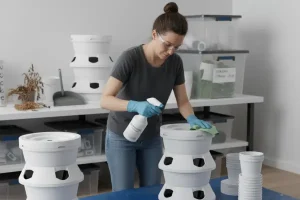A vertical garden is only as strong as its frame. Whether you’re building a compact herb wall or a large outdoor display, the frame supports your planters, irrigation system, and sometimes even lighting. Choosing the right material—metal, wood, or PVC—can affect durability, cost, and overall design.
This guide compares these three popular frame materials to help you decide which is best for your vertical garden.
Before you choose, take a minute to assess where the frame will live and how it will be used. Check your wall type (studs, masonry, or drywall), expected weight when fully watered, and exposure to sun, rain, or indoor humidity. Think about your irrigation style (hand-watered pockets vs. drip lines), the tools you have, and how much maintenance you’re willing to do each season.
Renters may prefer freestanding or rail-mounted systems, while homeowners can anchor into studs for higher loads. If you love flexibility, consider a hybrid: a sturdy main frame with modular panels you can swap as your plants—and ideas—grow.
Why Frame Material Matters
Your frame is the backbone of a vertical garden. Pick the right material and your wall stays safe, attractive, and easy to maintain for years.
Budget: Prices vary widely. Plastics and basic metals are affordable; hardwoods and powder-coated aluminum cost more but last longer.
Durability: Good materials resist moisture, UV light, and daily wear. Outdoors, look for weatherproof options that won’t warp, rust, or crack through seasons.
Weight capacity: Strong frames hold more planters, water, and media without bending. If you plan to grow heavier crops (like strawberries or small peppers), choose a frame rated for the load.
Style: The frame sets the mood—sleek metal for modern spaces, warm wood for a natural look, or matte composites for a clean, minimal vibe.
Maintenance: Some materials need more care than others. Wood may require sealing; steel might need rust protection; plastics usually just wipe clean.
Option 1: Metal Frames
Best For: Long-lasting outdoor vertical gardens.
Pros:
- Extremely durable, handles heavy loads.
- Weather-resistant if galvanized or powder-coated.
- Sleek, modern look.
- Low maintenance compared to wood.
Cons:
- Higher cost upfront.
- May rust if coating wears off.
- Heavy to move once installed.
Common Uses:
- Steel or aluminum grid walls.
- Modular outdoor towers.
- Commercial or large-scale setups.
Option 2: Wood Frames
Best For: Natural, decorative gardens.
Pros:
- Warm, rustic appearance.
- Easy to cut, shape, and build at home.
- Affordable if using common lumber.
- Renewable and eco-friendly (if sustainably sourced).
Cons:
- Requires sealing or treatment to resist rot.
- Heavier than PVC.
- May warp or split over time.
Common Uses:
- Balcony or patio herb walls.
- Decorative floral displays.
- DIY projects using pallets or reclaimed wood.
Option 3: PVC Frames
Best For: Lightweight, budget-friendly gardens.
Pros:
- Inexpensive and widely available.
- Easy to cut and assemble with simple tools.
- Lightweight and portable.
- Resistant to water and rot.
Cons:
- Not as strong as wood or metal.
- Can look less attractive without finishing.
- May weaken in very hot or sunny climates.
Common Uses:
- DIY towers for herbs and strawberries.
- Indoor systems with grow lights.
- Entry-level or experimental gardens.
Quick Comparison Table
| Feature | Metal | Wood | PVC |
| Durability | High | Medium | Medium-Low |
| Cost | $$$ (expensive) | $$ (moderate) | $ (affordable) |
| Weight Capacity | High | Medium-High | Low-Medium |
| Appearance | Modern, sleek | Rustic, natural | Simple, plain |
| Maintenance | Low | High | Low |
| DIY Friendliness | Medium | High | High |
Common Mistakes to Avoid
- Skipping protective coatings on wood or metal – leads to early damage.
- Overloading PVC frames – they can bend or collapse under too much weight.
- Not considering weather exposure – choose based on climate (PVC weakens in heat, untreated wood rots in rain).
- Focusing only on cost – cheapest isn’t always best for long-term results.
FAQs
Q: Can I combine materials in one frame?
Yes. Many DIY gardeners use a mix, such as a wooden frame with PVC pipes for irrigation.
Q: What’s the easiest material for beginners?
PVC is light, cheap, and easy to cut, making it beginner-friendly.
Q: How do I protect wood frames outdoors?
Use weatherproof sealant or outdoor paint. Reapply every year or two.
Q: Which material lasts the longest?
Metal frames, especially galvanized steel or aluminum, can last decades with minimal care.
Q: Can my wall handle the weight?
Aim for 15–25 lb/ft² when planted and wet; heavy crops can reach 30–35 lb/ft². Use appropriate anchors and check manufacturer load ratings.
Q: Can I mount a frame on drywall?
Yes, but only into studs or a French cleat/rail system. Otherwise, choose a freestanding frame to avoid wall damage.
Q: Will metal frames rust indoors?
Humidity can cause condensation. Choose powder-coated, galvanized, or stainless steel and add rubber spacers so the frame doesn’t sit flush against the wall.
Q: Are recycled plastic/composite frames safe for edibles?
Look for food-safe, BPA-free, UV-stabilized products. If unsure, use an inert liner between the planter and the frame.
Next Steps & Related Reading
For lightweight DIY options, see DIY Mounting Systems: Brackets, Rails & Planter Hooks.
To protect your investment, check How to Sterilize & Store Equipment Between Growing Seasons.
Conclusion
The best frame material for your vertical garden depends on your goals. Metal offers strength and longevity, wood provides natural beauty and DIY potential, while PVC is affordable and easy for beginners. By weighing durability, cost, and appearance, you can build a frame that keeps your vertical garden thriving for years.
Would you prefer the strength of metal, the charm of wood, or the affordability of PVC for your next project?




